
Kochi, also known by its former name Cochin, is a major port city along the Malabar Coast of India bordering the Laccadive Sea. It is part of the district of Ernakulam in the state of Kerala. The city is also commonly referred to as Ernakulam. As of 2011, the Kochi Municipal Corporation had a population of 677,381 over an area of 94.88 km2, and the larger Kochi urban agglomeration had over 2.1 million inhabitants within an area of 440 km2, making it the largest and the most populous metropolitan area in Kerala. Kochi city is also part of the Greater Cochin development region and is classified as a Tier-II city by the Government of India. The civic body that governs the city is the Kochi Municipal Corporation, which was constituted in the year 1967, and the statutory bodies that oversee its development are the Greater Cochin Development Authority (GCDA) and the Goshree Islands Development Authority (GIDA).

Ernakulam is one of the 14 districts in the Indian state of Kerala, and takes its name from the eponymous city division in Kochi. It is situated in the central part of the state, spans an area of about 2,924 square kilometres (1,129 sq mi), and is home to over 9% of Kerala's population. Its headquarters are located at Kakkanad. The district includes Kochi, also known as the commercial capital of Kerala, which is famous for its ancient churches, Hindu temples, synagogues and mosques.

Model Engineering College or MEC is a government cost-sharing technical institute and research centre in Thrikkakara, Kochi, Kerala, India. It was established by the Institute of Human Resources Development (IHRD), an autonomous agency under the Government of Kerala, in 1989. It is affiliated to the APJ Abdul Kalam Technological University (KTU) since 2015.

The Paradesi Synagogue aka Cochin Jewish Synagogue or the Mattancherry Synagogue is a synagogue located in Mattancherry Jew Town, a suburb of the city of Kochi, Kerala, in India. It was built in 1568 A.D. by Samuel Castiel, David Belila, and Joseph Levi for the flourishing Paradesi Jewish community in Kochi. Cochin Jews were composed mainly of the much older Malabari Jews and the newly arrived Sephardic refugees from the Portuguese religious persecution of Jews in Spain and Portugal. It is the oldest active synagogue in the Commonwealth of Nations. Paradesi is a word used in several Indian languages, and the literal meaning of the term is "foreigners", applied to the synagogue because it was built by Sephardic or Portuguese-speaking Jews, some of them from families exiled in Aleppo, Safed and other West Asian localities.
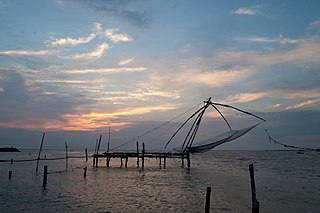
Fort Kochi, also known by its former name Fort Cochin is a neighbourhood of Cochin (Kochi) city in Kerala, India. Fort Kochi takes its name from the Fort Manuel of Cochin, the first European fort on Indian soil, controlled by the Portuguese East Indies. This is part of a handful of water-bound islands and islets toward the south-west of the mainland Kochi, and collectively known as Old Cochin or West Cochin. Adjacent to this is the locality of Mattancherry. In 1967, these three municipalities along with a few adjoining areas, were amalgamated to form the Kochi Municipal Corporation.

Cherai is a small town located in north side of Vypin island. It is a region in the suburb of the city of Kochi, in the state of Kerala, India. It is at a distance of about 22.6 km (14.0 mi) from the High Court Junction, Kochi. Cherai has the longest beach in Kochi - the Cherai beach. The beach is located towards the centre-north of the Vypin island.

Ernakulam is the central business district of the city of Kochi, Kerala, India. It is the namesake of Ernakulam district. The eastern part of Kochi city is mainly known as Ernakulam, while the western part of it after the Venduruthy Bridge is called as Western Kochi. Many major establishments, including the Kerala High Court, the office of the Kochi Municipal Corporation and the Cochin Shipyard are situated in Ernakulam. It is also the most urbanized area in the city of Kochi.

Kerala, a state situated on the tropical Malabar Coast of southwestern India, is one of the most popular tourist destinations in the country. Named as one of the ten paradises of the world by National Geographic Traveler, Kerala is famous especially for its ecotourism initiatives and beautiful backwaters. Its unique culture and traditions, coupled with its varied demography, have made Kerala one of the most popular tourist destinations in the world. Several international agencies ranging from UNESCO to National Geographic have recognised the state's tourism potential. Kerala was named by TIME magazine in 2022 among the 50 extraordinary destinations to explore in its list of the World's Greatest Places. In 2023, Kerala was listed at the 13th spot in The New York Times' annual list of places to visit and was the only tourist destination listed from India.
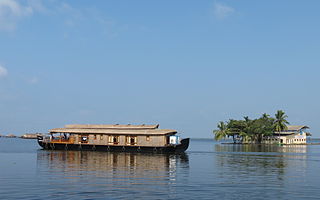
Kerala, called Keralam in Malayalam, is a state on the Malabar Coast of India. It was formed on 1 November 1956, following the passage of the States Reorganisation Act, by combining Malayalam-speaking regions of the erstwhile regions of Cochin, Malabar, South Canara, and Travancore. Spread over 38,863 km2 (15,005 sq mi), Kerala is the 21st largest Indian state by area. It is bordered by Karnataka to the north and northeast, Tamil Nadu to the east and south, and the Lakshadweep Sea to the west. With 33 million inhabitants as per the 2011 census, Kerala is the 13th-largest Indian state by population. It is divided into 14 districts with the capital being Thiruvananthapuram. Malayalam is the most widely spoken language and is also the official language of the state.
Kochi, formerly known as Cochin, is a city and port in the Indian state of Kerala.
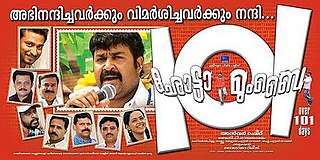
Chotta Mumbai is a 2007 Indian Malayalam-language action comedy film directed by Anwar Rasheed, written by Benny P. Nayarambalam, and co-produced by Maniyanpilla Raju. The film stars Mohanlal in the lead role with Siddique, Jagathy Sreekumar, Kalabhavan Mani, Indrajith Sukumaran, Manikuttan, Bijukuttan, Sai Kumar, and Bhavana in supporting roles. Rahul Raj composed the score and songs of the film. The plot follows Vasco da Gama (Thala) and his gang of friends, all unemployed and leading a happy-go-lucky life until they encounter a corrupt police officer and gangster, Nadeshan.

Bhoothathankettu is a dam and tourist spot in Ernakulam district in Kerala,. It is situated outside the village of Pindimana, about 10 km away from the town of Kothamangalam and 50 km away from the main city of Kochi. The original natural dam has been supplemented by a modern dam impounding the Bhoothathankettu Reservoir.

Hill Palace is an archaeological museum and palace located in the Thrippunithura neighbourhood of Kochi, Kerala. It is the largest archeological museum in the state and was the imperial administrative office and official residence of the Cochin Maharaja. Built in 1865, the palace complex consists of 49 buildings spreading across 54 acres (220,000 m2) and built in the traditional architectural style. The complex has an archaeological museum, a heritage museum, a deer park, a pre-historic park and a children's park.

Kerala Varma Thampuran popularly known as Aikya Keralam Thampuran or Kerala Varma VII was the Maharaja (king) of Cochin who ruled between 1946 and 1949. He mooted the idea of a unified Kerala state in India for the Malayalam speaking population and stood for the merging of British Malabar, Cochin and Travancore. Therefore, he was given the sobriquet Ikyakeralam Thampuran. He died in July 1948. He was also the brain behind the formation of Sree Kerala Varma College at Thrissur, named after him.

Abul Kalam Azad is a noted contemporary Indian photographer. Abul's photographic works are predominantly autobiographical and expose the areas of politics, culture, contemporary history, gender and eroticism. His works attempts a re-reading of contemporary Indian history – the history in which ordinary people are absent and mainly provided by beautiful images and icons. Abul's works makes an active intervention in the common illustrative discourse of this history. Using the same tool, photography, that chisels history out of a block of ‘real’ human experiences, Abul makes a parody of it. 'Overall, the corpus of Azad's work can be seen to have a thrust towards an archive of local micro-history at the level of personal memory and in that sense, his works add up to a kind of social anthropology of his land and its people, though not necessarily in the line of tradition of the objective documentary'. Abul Kalam Azad is the visionary behind EtP Ekalokam Trust for Photography, a Trust dedicated to preserving and promoting contemporary Photography. He is also the Director of Project 365, a public photo art project that collectively creates and preserves photographic visuals of the fast changing culture and lifestyle of ancient Tamilakam. He is the Editor-in-Chief of Photo Mail online magazine.
Thomas Burleigh Kurishingal is an Indian actor, director, producer, script writer, music composer in Malayalam cinema, and author of in English.
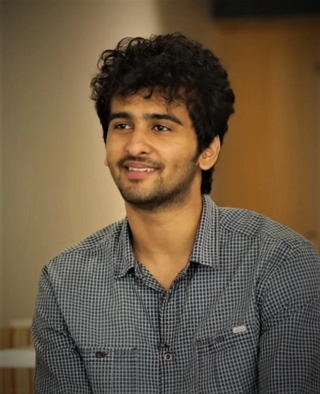
Shane Nigam is an Indian actor who appears in Malayalam films. Having made his debut in a credited role with the 2013 road film Neelakasham Pachakadal Chuvanna Bhoomi (2013), he went to receive wider attention for his performances in various successful drama films Kismath (2016), Parava (2017), Kumbalangi Nights (2019), Ishq (2019), Bhoothakaalam (2022), and RDX: Robert Dony Xavier (2023).
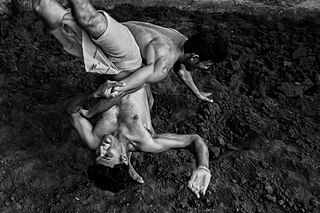
Gatta gusthi is a form of submission wrestling practiced in Kerala, India. It is competed inside an open ring on the ground, usually on a beach, known as godha. Wrestlers are called phayalvans. The sport consists of around 100 techniques. Gatta gusthi was popular in the state until the arrival of freestyle wrestling and karate in late 1960s. Its freestyle form is known simply as gusthi.
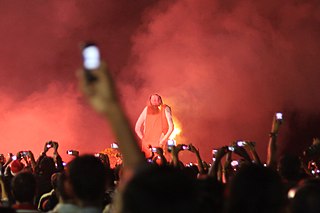
Pappanji is an effigy of an old man, prepared as part of the New Year celebrations in Fort Kochi, Kerala. It is prepared in the form of an old man as a symbol of the passing year. With Pappanji being burned at midnight on the last day of December, the concept is that the year is over. Although thought to have originated from the remnants of the Christmas and New Year celebrations of the Portuguese, it is now considered a secular festival.

RDX: Robert Dony Xavier is a 2023 Indian Malayalam-language action thriller film directed by Nahas Hidayath in his directorial debut, and produced by Sophia Paul under Weekend Blockbusters. It stars Shane Nigam, Antony Varghese and Neeraj Madhav in titular roles, alongside Babu Antony, Lal, Mahima Nambiar, Aima Rosmy Sebastian, Maala Parvathi and Baiju in supporting roles. The film revolves around Robert, Dony and Xavier's crusade to exact vengeance against Paulson and his gang for assaulting their family.

















